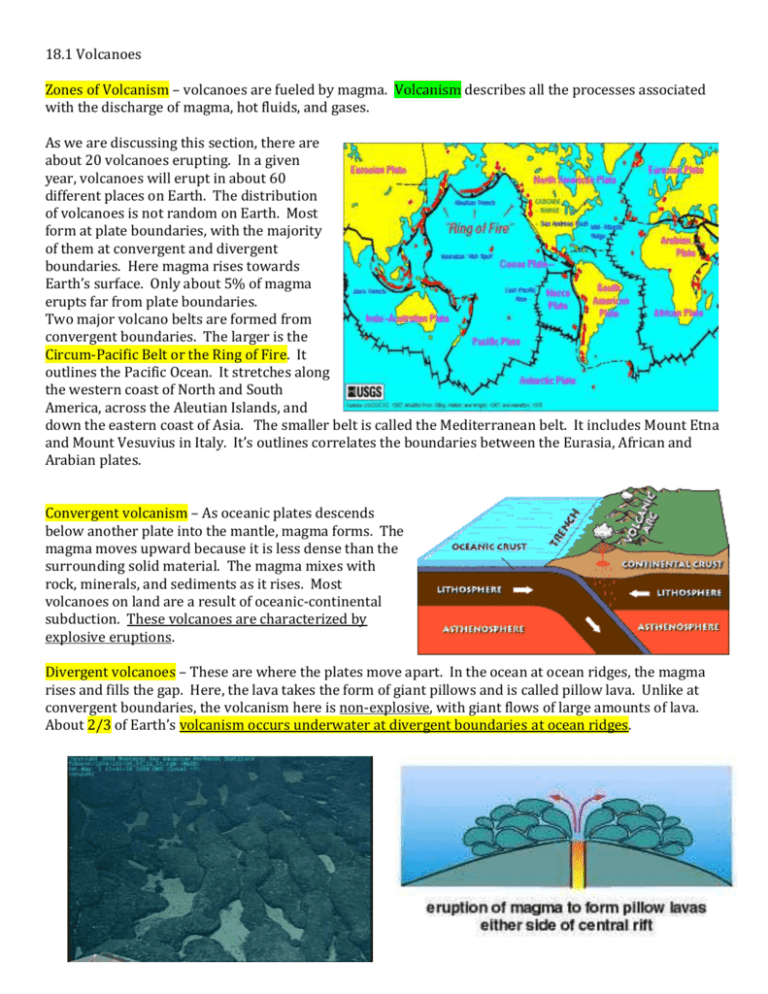18.1-notes-volcanoes
advertisement

18.1 Volcanoes Zones of Volcanism – volcanoes are fueled by magma. Volcanism describes all the processes associated with the discharge of magma, hot fluids, and gases. As we are discussing this section, there are about 20 volcanoes erupting. In a given year, volcanoes will erupt in about 60 different places on Earth. The distribution of volcanoes is not random on Earth. Most form at plate boundaries, with the majority of them at convergent and divergent boundaries. Here magma rises towards Earth’s surface. Only about 5% of magma erupts far from plate boundaries. Two major volcano belts are formed from convergent boundaries. The larger is the Circum-Pacific Belt or the Ring of Fire. It outlines the Pacific Ocean. It stretches along the western coast of North and South America, across the Aleutian Islands, and down the eastern coast of Asia. The smaller belt is called the Mediterranean belt. It includes Mount Etna and Mount Vesuvius in Italy. It’s outlines correlates the boundaries between the Eurasia, African and Arabian plates. Convergent volcanism – As oceanic plates descends below another plate into the mantle, magma forms. The magma moves upward because it is less dense than the surrounding solid material. The magma mixes with rock, minerals, and sediments as it rises. Most volcanoes on land are a result of oceanic-continental subduction. These volcanoes are characterized by explosive eruptions. Divergent volcanoes – These are where the plates move apart. In the ocean at ocean ridges, the magma rises and fills the gap. Here, the lava takes the form of giant pillows and is called pillow lava. Unlike at convergent boundaries, the volcanism here is non-explosive, with giant flows of large amounts of lava. About 2/3 of Earth’s volcanism occurs underwater at divergent boundaries at ocean ridges. Hot Spots – Some volcanoes form far from plate boundaries over hot spots. Hot spots are unusually hot regions of Earth’s mantle where high-temperature plumes of magma rises to the surface. The Hawaiian Islands are over a plume of magma. As the rising magma melted through the crust, it formed volcanoes. The hot spot formed by the magma plume remained stationary while the Pacific Plate moved slowly northwest. Over time, the hot spot left a trail of volcanic islands on the Floor of the Pacific Ocean. The oldest volcanoes in the Hawaiian chain are no longer active because they are not longer over the hot spot. Even older volcanoes aren’t even above sea level. Kilauea is the current active volcano on the big island of Hawaii because it is currently over the hot spot. Another new volcano, Loihi, is forming on the seafloor southeast of the big island and might eventually rise above the oceans surface. If a hot spot occurs beneath continental crust, they can lead to the formation of flood basalts. Flood basalts form when lava flows out of long cracks in Earth’s crust. The cracks are called fissures. Over hundreds of thousands of years, these fissure eruptions can lead to the formation of plateaus. The volume of basalt erupting from fissures can be tremendous. The Columbia River basalt in the state of Washington could fill Lake Superior 15 times. There is an even bigger basalt in India that could cover the island of Manhattan with a layer of lava 6,213 miles thick or all of New York with a layer 2.5 miles thick. The huge flow in India happened about 65 mya and this is what scientists believe lead to the extinction of the dinosaurs. Anatomy of a Volcano – Lava reaches the Earth’s surface through a tube-like structure called a conduit, and emerges through an opening called a vent. As the lava cools and solidifies, it will begin to layer and form a volcano. At the top of the volcano, around the vent, is a bowl-shaped depression called a crater. The crater is connected to the magma chamber by the conduit. Volcanic craters are usually less than 1 km (.62 mi) in diameter. A caldera is a large depression that is formed after the magma chamber empties completely of magma. When this happens, the summit or side of the volcano will collapse into the empty chamber, leaving an expansive, circular depression. Sometimes water will fill this space forming a lake. Crater Lake in Oregon is an example. conduit Types of volcanoes – Volcanoes are categorized by two things: the type of material that forms the volcano and the type of eruption that occur. There are three main types of volcanoes. Shield volcanoes broad , gently sloping sides nearly circular base form when layers of lava accumulate during quiet nonexplosive eruptions largest type of volcano Cinder cone volcano formed when small pieces of material are ejected, fall back to Earth and pile up around the vent steep sides generally small, most less than 500m (1,640ft) high form on or very near larger volcanoes explosive eruptions Composite volcano formed of layers of hardened chunks of lava from violent eruptions alternating with layers of lava that oozed downslope before solidifying generally cone-shaped with concave slopes larger than cinder cones very explosive eruptions, very dangerous to humans and the environment tall, majestic mountains






